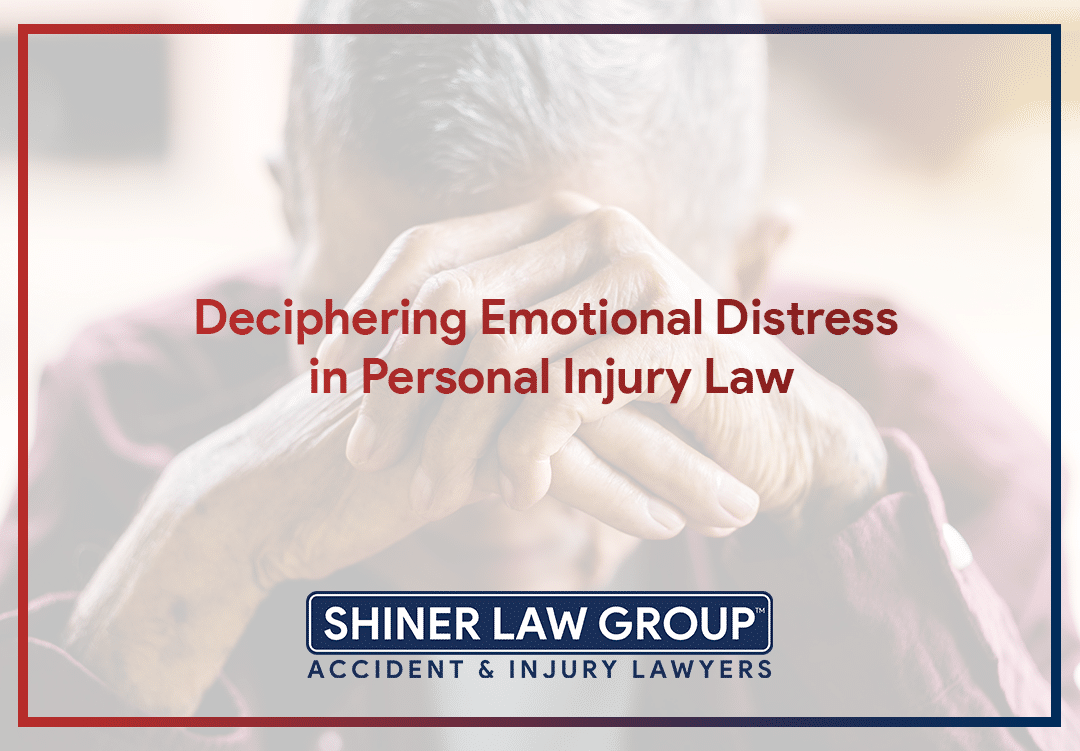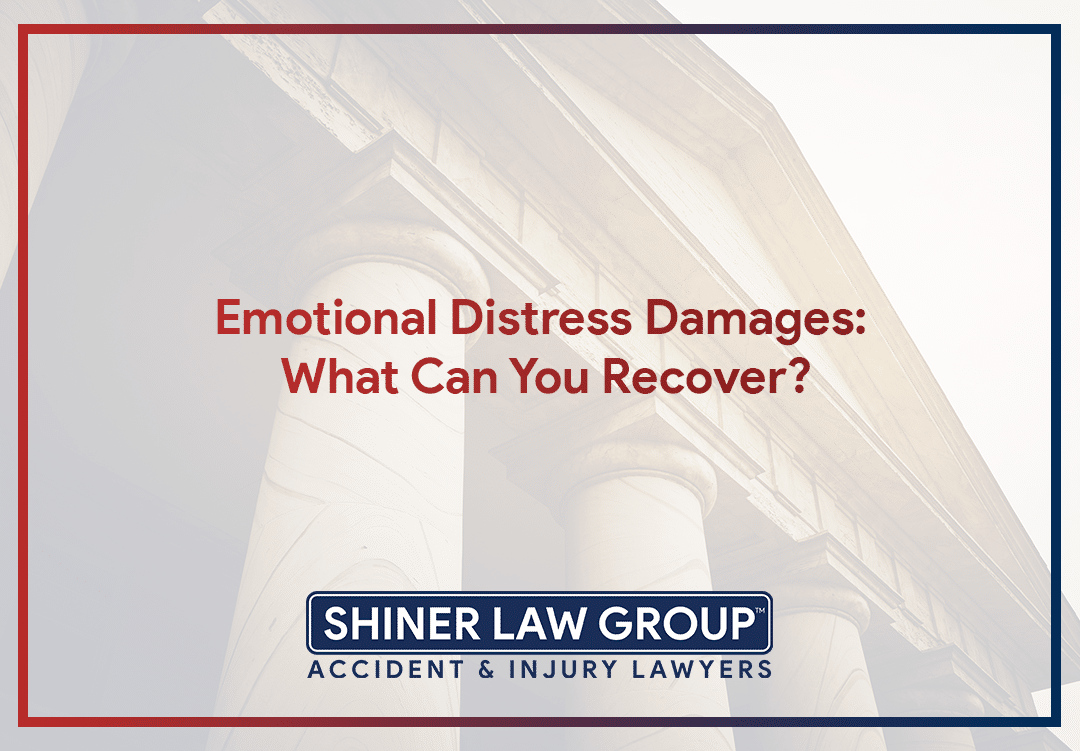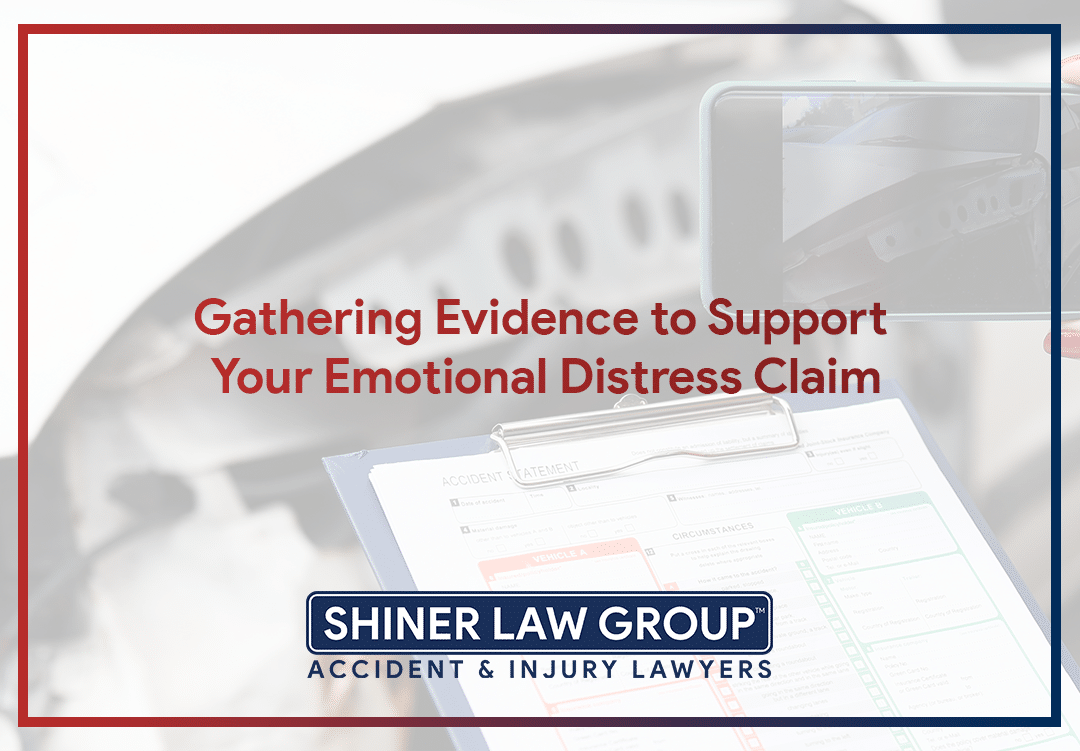Understanding emotional distress claims in personal injury cases is vital for anyone involved in such a case, as these claims can significantly impact the outcome. By knowing the ins and outs of understanding emotional distress claims in personal injury cases, plaintiffs and defendants alike can better navigate the complexities of personal injury law and pursue a fair resolution.
Key Takeaways
- Comprehending emotional distress in personal injury law and its effects on various case types.
- Gathering evidence to prove a direct correlation between the injury and emotional trauma experienced by the plaintiff.
- Partner with an experienced attorney to maximize chances of achieving favorable outcomes for claims such as pecuniary loss, emotional distress, etc.
Deciphering Emotional Distress in Personal Injury Law

Emotional distress in personal injury cases refers to the psychological and emotional injuries suffered by a victim, which can include:
- anxiety
- depression
- post-traumatic stress disorder (PTSD)
- other mental health issues
Unlike physical injuries, emotional distress claims can be more challenging to prove, as they often rely on subjective evidence and a direct link between the defendant’s actions and the victim’s emotional harm.
The legal definition of emotional distress varies from state to state. For example, in Illinois, emotional distress includes “significant” alarm, anxiety, or suffering caused by a physical injury or other traumatic event. In Texas, emotional distress damages can be categorized as intentionally inflicted or caused by an inflicted injury and negligently inflicted emotional distress, which can include mental anguish.
Recognizing the significance of emotional distress, equivalent to physical injuries in personal injury cases, is necessary. Emotional distress is classified as “non-economic” damage in a personal injury claim, as it cannot be quantified by an objective monetary value. An experienced personal injury attorney can provide the necessary guidance and support in navigating complex personal injury claims involving emotional distress.
The Anatomy of an Emotional Distress Claim
An emotional distress claim involves demonstrating that:
- The plaintiff’s emotional anguish is causally related to the defendant’s conduct or negligence
- The distress is grave enough to merit remuneration
- The distress often results from a traumatic event
- The plaintiff must prove emotional distress
To establish emotional distress as a direct consequence of the defendant’s actions or negligence, such as intentionally inflicted emotional distress, and that it is of sufficient severity to merit compensation, a claimant must provide evidence that the distress has had a significant effect on their life.
The essential components of an emotional distress claim in personal injury law comprise extreme or outrageous conduct, intentional or reckless conduct, and severe emotional distress or injury. A claimant, upon verifying these components, can pursue compensation for damages related to their emotional distress.
However, the process of verifying emotional distress is not simple. It often relies on subjective evidence and requires a direct connection between the defendant’s actions and the victim’s emotional suffering. This can involve:
- Collecting medical records
- Expert testimony
- Witness statements
- Documentation of the victim’s mental health treatment
The Challenges of Proving Emotional Distress
One of the primary challenges in pursuing a claim for emotional distress in a personal injury case is that emotional distress is not as readily discernible as physical pain and suffering, making the claim process quite arduous. Establishing a direct correlation between the injury and the emotional distress experienced by the plaintiff is a prerequisite for proving emotional distress in a personal injury case.
Some of the elements considered when establishing the presence of emotional distress in a personal injury lawsuit include:
- Information from medical records
- Specialist testimony
- Witness accounts
- Records of mental health treatment
However, gathering such evidence can be difficult, as emotional distress is often subjective and may vary in intensity from person to person.
Considering the challenges in proving emotional distress, it’s beneficial to partner with a seasoned personal injury attorney who can navigate the intricacies of emotional distress claims and accumulate the required evidence to support the claim.
Emotional Distress Damages: What Can You Recover?

Emotional distress damages can include compensation for pain and suffering, loss of enjoyment of life, and other non-economic damages related to the victim’s mental health. In Texas, emotional distress damages are considered non-economic damages, as they are not physical injuries and are more subjective in nature.
Determining the damages for emotional distress can be complex. In Texas, the multiplier method is typically employed to calculate pain and suffering damages in emotional distress cases. This entails multiplying the total amount of economic damages by a certain factor to determine the pain and suffering damages. It should be noted, however, that Texas courts have set a cap of $250,000 on pain and suffering damages in medical malpractice cases.
To assert a claim for loss of enjoyment of life in Texas personal injury cases, claimants can demonstrate it through testimony from themselves, their spouse, friends, or other witnesses. It is imperative to consult with a personal injury attorney who can guide the claimant through the procedure and assist in seeking compensation for non-economic damages.
Intentional vs. Negligent Infliction of Emotional Distress
Intentional infliction of emotional distress involves proving that the defendant acted outrageously and intentionally caused the victim’s emotional trauma. In contrast, negligent infliction of emotional distress is a form of negligence wherein the defendant’s careless actions lead to the victim suffering from serious emotional distress.
The differentiation between intentional and negligent infliction of emotional distress is substantial, as it sets the legal grounds for seeking compensation in a personal injury case. Intentional infliction of emotional distress requires demonstrating that the defendant acted in an outrageous manner and deliberately caused the victim’s emotional trauma, while negligent infliction necessitates demonstrating that the defendant’s negligence resulted in emotional distress.
Examples of negligent infliction of emotional distress can include:
- Witnessing a family member or loved one’s serious injury or death
- Being involved in a traumatic accident caused by someone’s negligence
- Enduring emotional harm due to someone’s careless actions
Gathering Evidence to Support Your Emotional Distress Claim

Supporting an emotional distress claim may necessitate the following documents:
- Medical records: documentation of symptoms, treatment, and progress related to emotional distress; medical history demonstrating the treatment received for emotional distress; records of seeking medical treatment specifically for emotional distress
- Expert opinions: opinions from mental health professionals or other experts in the field
- Witness accounts: statements from individuals who have observed the victim’s emotional distress
- Documents related to mental health treatment: records of therapy sessions, counseling, or other forms of treatment
- Employment records: records that can corroborate the emotional distress claim, such as performance evaluations or disciplinary actions
- Any other records that provide an in-depth account of the injuries and their effect on emotional well-being
These documents can help illustrate the extent of emotional distress in a personal injury lawsuit.
Therapy notes can also be used as evidence in emotional distress claims by providing detailed medical documentation that attests to the claimant’s symptoms, outlines their diagnosis and prognosis, and illustrates the influence of the emotional distress on their daily life. Witness statements can also be effective in demonstrating emotional distress, particularly if they provide detailed and specific accounts of the events that caused the distress, the effect it had on the individual’s daily life and well-being, and any perceptible changes in behavior or mental state.
Working with an experienced personal injury attorney can help in gathering the necessary evidence to support an emotional distress claim and ensure that the claim is presented effectively in court or during negotiations with an insurance company.
Why Partner with an Experienced Personal Injury Attorney
Collaborating with a seasoned personal injury attorney can assist in navigating the complexities of emotional distress claims, accumulating necessary evidence, and advocating for just compensation. An experienced attorney can provide guidance in navigating the complexities of emotional distress claims, collecting pertinent evidence, and advocating for equitable compensation.
When choosing a personal injury attorney for filing an emotional distress claim, consider the following factors:
- Track record
- Meticulousness
- Negotiation skills
- Communication ability
- Understanding of medical matters
An experienced attorney can increase the probability of obtaining compensation for an emotional distress case.
Furthermore, a seasoned personal injury attorney can steer clients through different stages of their emotional distress case, from claim filing to negotiation with insurance companies and, if required, court representation. By partnering with an experienced attorney, claimants can increase their chances of achieving a favorable outcome in their emotional distress case.
Impact of Emotional Distress on Specific Case Types
In various types of personal injury cases like car accidents, premises liability, and traumatic brain injuries, emotional distress can have a noteworthy influence. In car accident personal injury cases, emotional distress compensation can cover the emotional distress and its impact on various aspects of the victim’s daily life. However, emotional distress claims can be difficult to prove in court due to their subjective nature.
In traumatic brain injury cases, signs of a traumatic brain injury may manifest shortly after the incident or even in the subsequent weeks. Long-term psychological effects associated with concussions may include changes in mood, difficulty in recollection of events, and fatigue. Emotional distress can be a major factor in these cases, as the long-term psychological effects can significantly impact the victim’s life.
Emotional distress can also play a significant role in premises liability cases, as victims may experience emotional trauma from the incident, leading to depression, anxiety, and other mental health issues. In all these cases, understanding the impact of emotional distress on the specific case type and gathering the necessary evidence can be crucial in achieving a fair resolution.
Compensation Beyond Medical Expenses
Compensation for emotional distress can offer victims financial relief exceeding medical costs, addressing the psychological impact of their injuries and aiding their progress in life. Emotional distress compensation in personal injury cases can cover expenses such as:
- Medical expenses
- Lost income
- Pain and suffering
- Punitive damages
The distinction between emotional distress compensation and medical expense reimbursement in personal injury lawsuits is that emotional distress compensation denotes the damages awarded to a victim for the psychological and emotional suffering they have experienced due to the injury, while medical expense reimbursement encompasses the costs of medical treatment and expenses incurred by the victim as a result of the injury.
There have been documented cases in which emotional distress compensation was substantially higher than medical expenses, such as a 1999 case where a jury awarded $4,000,000 in compensatory damages for pecuniary loss, emotional distress, and other related claims. By understanding the potential for compensation beyond medical expenses, victims can seek the financial relief they need to address the full scope of their injuries, both physical and emotional.
Concluding Emotional Distress in Personal Injury Cases
In conclusion, understanding emotional distress claims and their impact on personal injury cases is essential for anyone involved in a personal injury case. By being familiar with the complexities of emotional distress claims, gathering the necessary evidence, and partnering with an experienced personal injury attorney, plaintiffs and defendants alike can pursue a fair resolution that addresses the full scope of their injuries and the psychological impact they have experienced.
Frequently Asked Questions
How do they value emotional distress in lawsuits?
Judges and juries typically take the severity of emotional distress into consideration when determining the value of non-economic damages in lawsuits. Such damages are more difficult to quantify because they do not have a direct monetary value.
Are emotional distress damages compensatory damages?
Yes, emotional distress damages are a form of compensatory damages.
Does emotional distress count as a personal injury?
Yes, emotional distress can be classified as a form of personal injury. Psychological and emotional harm count as injuries that may result from an event or series of events.
What is an example of emotional damage?
Emotional damage can be the result of physical trauma or emotional situations, such as brain trauma that leads to forgetfulness, insecurities caused by permanent scars, or physical reactions.
What is emotional distress in personal injury cases?
Emotional distress is a psychological and emotional injury suffered by victims of personal injury cases, such as anxiety, depression, and PTSD.